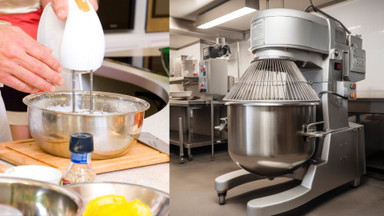Sep 18th 2023
The Difference Between Belt-Driven and Gear-Driven Mixers
Every day, restaurants produce various dishes dependent on house-made dough. Mixing that dough, especially with a dense recipe, requires a hardworking mixer you can depend on. However, mixers ready for the challenge of a dense recipe are often more expensive. Some restaurants don’t have the time to save for a fancy mixer. If you can’t decide what to get, we can help. Keep reading for a detailed comparison of the difference between belt-driven and gear-driven mixers.
Belt-Driven Mixer
The transmission in a belt-driven mixer is identifiable from its name. It uses a belt. Belts are often more affordable to produce and fix, which makes belt-driven mixers a more accessible option for many restaurants. This affordability doesn’t mean that they’re low quality, though. You’ll still bring a good mixer into your restaurant if you choose one. It even lets you easily change between multiple speed settings while the mixer is running.
Gear-Driven Mixer
The gear-driven transmission also comes from its name: metal gears. Gears often have more intricate pieces and require more work to repair, so they’re more expensive than their belt-using counterparts. However, they can also transfer more power from the motor into the mixing mechanism, which is necessary for dense doughs. The extra power can make them more efficient than belt-driven mixers. Most gear-driven mixers come with two fixed settings, and you must turn the mixer off to change between the two.
Which Is Better: Belt-Driven or Gear-Driven Mixers?
Every restaurant is different, so we hesitate to recommend one type of mixer over the other. However, we personally prefer the gear-driven mixer. The difference between the belt-driven and gear-driven mixers is mostly visible in the available efficiency. While the belt-driven ones can get the job done and offer more customization with speeds, the additional power and efficiency of the gear-driven types can be quite useful. The extra power can create more noise than the belt-driven alternative, but we still believe it’s a great investment for your restaurant.
After examining the differences between mixer options, you can decide which is best for your restaurant. While we’re partial to professional dough mixers with a gear transmission, belt-driven ones are still valid options for many commercial kitchens. As long as your chosen mixer works well in your kitchen and helps you satisfy hungry customers, it’s the right choice.

